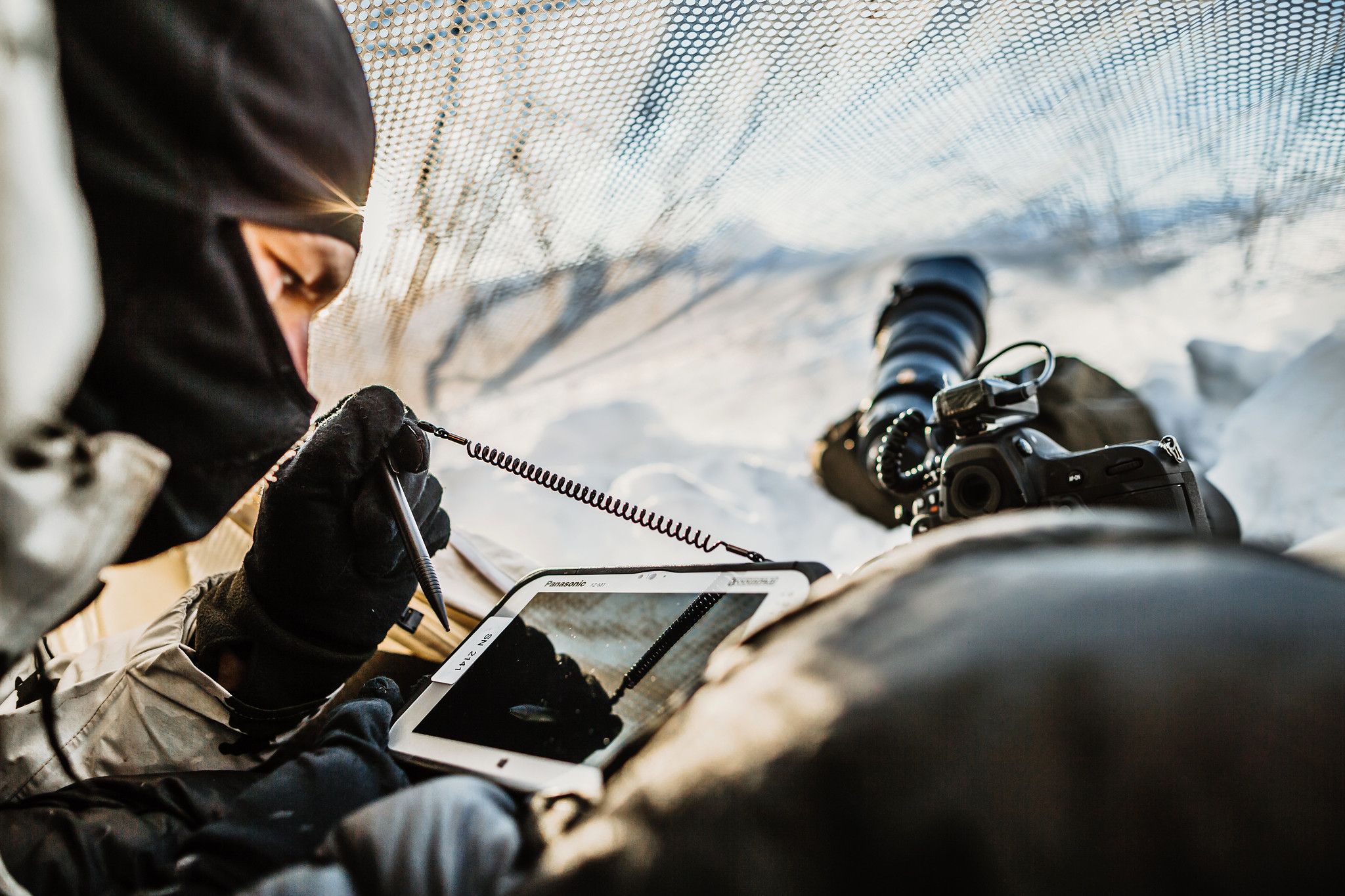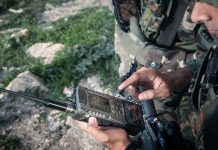Launched in 2018, the ‘Digitisation of Land-Based Operations’ (D-LBO) programme has been an effort with regard to the imperative modernisation of the land forces’ command and control capability in support of mobile operations. This not only applies to the Army, but also covers the land-based elements of the other service branches.
Merging the “Mobile Tactical Communication” (Mobile Taktische Kommunikation – MoTaKo) and “Mobile Tactical Information Processing Land” (Mobile Taktische Informationsverarbeitung Land – MoTIV) programmes in the scope of the D-LBO programme, is intended to provide a basis for the command and control of networked operations (Vernetzte Operationsführung – NetOpFü). To this end, D-LBO provides the necessary IT services at the tactical level for mobile elements (soldiers and vehicles/platforms) and command elements (including command posts, in particular at the battalion/unit level) in a secure, robust, end-to-end IP-capable and interoperable land forces information and communication network.
After the Inspector-General of the Bundeswehr selected the solution for Force Disposition 1 (KD 1) share in March 2020, the D-LBO programme officially commenced. D-LBO must be regarded as a paradigm shift. It is not merely a matter of exchanging and supplementing radio equipment at the mobile level, but a combination of integrating a wide variety of information transmission systems (including UHF/ VHF radio, HF radio, cellular networks 4G/ LTE and satellite communication) with platforms and simultaneously providing essential IT services (for example, positioning, tactical picture, command, etc.) in the country’s information and communication network.
This essential part of the digitisation of land forces is based on a completely new architecture and new understanding of systems compared to the older systems still in use. Various requirements arise depending of forces and their platforms, so the programme is being managed as a whole by the Telecommunications Group in the Army Concepts and Capabilities Development Centre.
Standardisation as a Decisive Factor
During the planning phase of D-LBO, it was recognised that platform integration would be the main challenge. Almost 25,000 land forces vehicles must be equipped with D-LBO IT equipment. Here, challenges arise when comparing the long service life requirements of military platforms to the rapid innovation cycles of modern IT systems.
In order to be able to meet this challenge, uniform specifications were developed within the framework of the study ‘Standardised Equipment Kit Integration Bundeswehr’ (Standardisierte Rüstsatzintegration Bundeswehr – StaRSBw) to enable interoperability and cross-compatibility of system components across all platforms. At the same time, this should facilitate easier and faster replacement of IT hardware, which is important due to the short but necessary upgrade intervals.
The requirements are now considered as part of the performance specifications for future platforms in the “Technical Terms of Delivery” (TL A-0200) document, to ensure future-oriented procurement of IT components (essentially information transmission and processing systems).
As part of the standardised kit integration, two demonstrators (UTF 15 t truck and Mercedes Benz G-Class GREENLINER) were successfully built by the end of 2021 in order to demonstrate the feasibility of TL A-0200. This provided proof of concept that IT components can be used flexibly in platforms in the future. A continuation of this concept using an armoured platform is also planned by the Army Concepts and Capabilities Development Centre.
Originally, the D-LBO programme was to be carried out according to force elements (FE) in two-year intervals starting in 2023. In this context, a force element stood for an army brigade including the respective enablers from the other military organisational areas. In the course of developing FE 1, however, the scope had to be comprehensively narrowed.
Due to deployments, and alliance obligations like VJTF(L) 2023, there were not enough platforms available, and further problems arose due to insufficient funding and industry’s lack of capacity. In order to be able to integrate D-LBO-related IT equipment items with the platforms, a test integration must be carried out for almost every single platform type in service. This is an expensive and time-consuming process, requiring about 12 to 24 months. Only when this has been completed can serial integration be carried out.
In the course of the selection decision, the strength of FE 1 was thus set at approximately a reinforced battalion, which included forces from other organisational areas. This would comproxe approximately 880 platforms and 2,200 soldiers. The time-consuming and expensive test integrations, as well as further budget cuts meant that the scope of FE 1 had to be reduced in FE 1.1.
Under FE 1.1, the integration of D-LBO-related IT equipment is now planned for approximately 140 platforms from 2023 to 2025, such as the LEOPARD 2 main battle tank (MBT), the BOXER armoured personnel carrier (APC), the FUCHS APC, the EAGLE and DINGO protected patrol vehicles (PPVs), as well as unarmoured transport vehicles in the 5 tonne and 15 tonne payload classes.
Implementation of the Sub-Projects
The D-LBO system concept and one of its core elements, the Tactical Core, which serves as interface and routing middleware, meets these challenges in an innovative way. The Tactical Core enables the D-LBO network to react adaptively to various influences during a battle. For example, material or technical failures as well as terrain can have a negative impact on capacities and availability in the area of network connectivity. However, the Tactical Core can guarantee the exchange of data and information by using various means of transmission. In addition to routing capabilities, the Tactical Core has other critical functions, such as transparent network/user access and the provision of separate information security domains through which IT services can be delivered to mobile elements (e.g. the Battle Management System (BMS), voice communications, chat, template-based messaging, etc.). The Tactical Core is already at an advanced stage of development and is currently undergoing approval at the Federal Office for Information Security.
There are two different types of UHF and VHF radios – the soldiers’ radios, and the command and control (C2) radios. The C2 radios will operate in both UHF and VHF bands, whereas the soldier radios will only operate in the UHF band. The procurement process for the C2 radio started in September 2021. This procurement is critical, as it involves the replacement of completely obsolete SEM radios, most of which have been in use with the armed forces since the 1980s. These C2 radios will be procured in vehicle-mounted, handheld, and backpack variants. After the selection process is completed in in 2022, and a contract is planned to be issued for the beginning of 2023.
On the soldier radio side, the procurement process is even further along, with a contract to be awarded before the end of 2022. Additionally, the completion of the tender documents is near for many other sub-projects, such as satellite communication (SATCOM) on the Move (SOTM) systems, HF radios, as well as Cellular Networks (ZeN mob), and the procurement process is expected to start soon, with contracts for these sub-projects also expected to be awarded in 2023.
In the “Protected Mobile Command and Control Facility (Geschützte Bewegliche Führungseinrichtung – GBF) and Mobile Communications Node (Mobiler Kommunikationsknoten – MKK)” project, which is also part of the D-LBO programme, new IT equipment and platforms are being procured. GBF is envisioned as a generic mobile command platform, intended to succeed current mobile command posts. In the D-LBO network, MKK assumes tasks such as network densification, range extension (‘relay functionalities’) and enabling switching to other radio-based networks (e.g. within multinational interoperability scenarios). For GBF and MKK, different platforms can serve different levels of protection. Both GBF and MKK will be implemented on two protected vehicle platforms, which have not yet been selected, one of which will have medium protection, and the other high protection. In addition, there will be platform variants for Arctic and airborne operations. Compared to other platforms, GBF and MKK will be equipped with much more powerful information processing and transmission systems in order to be able to fulfil their tasks in the land network.
User Involvement during Procurement
In order to build up user expertise and to identify weaknesses or requirements in the system at an early stage, user tests are being carried out within the framework of TIME2D-LBO (Testing/ Integration/ Modulation/ Evaluation/ Enhancement) until the system is ready. The testing and experimentation structures in Munster are making a significant contribution to this with their technical expertise. At the same time, these tests are used to check and, if necessary, adapt existing concepts, and finally to prepare for operational-tactical testing of the entire D-LBO KD 1.1 system.
In May 2021, the first user test took place within this framework, during which IT technical and functional personnel were first trained on the tactical core and then tested and evaluated the software. It was found that the software already has a wide range of functions and is intuitive to use. Furthermore, areas for further development and adaptation, as well as opportunities for additional automation were pointed out. The results also feed into planning the training of future D-LBO administrators. The user tests will be expanded 2023 as the implementation/procurement of D-LBO FD 1.1 progresses.
D-LBO “Basic” as a Means for Improved Command Capability
Due to the aforementioned reductions in FD 1 to FD 1.1, it is expected to take a while for a significant quantity of D-LBO platforms to enter use. All new platforms will be equipped with new digital C2 equipment from 2023 onwards and the number of units will also gradually increase over the coming years, but greater efforts must be made to modernise the IT components of the existing platforms to beyond FD 1.1 by 2027.
Furthermore, the Battle Management System (BMS) operational test deployments for the VJTF (L) 2023 in early 2021 revealed that a modern BMS was significantly constrained in terms of data transmission by the limited capabilities of legacy SEM radios. Based on these findings, further possibilities had to be developed to progress the digitisation project more quickly, in order to achieve at least a ‘partial digitisation’, for the command capability envisioned in ‘Division 2027’. This is a particular focus of the Deputy Inspector-General of the Bundeswehr.
As such, efforts are underway to develop a ‘D-LBO Basic’ variant. To meet this goal, it may be possible to equip some platforms with fewer new components/software, as long as components/software are still based on the D-LBO system concept. Platforms equipped with C2 equipment and BMS for VJTF (L) 2023 are to be equipped with modern digital C2 radios, selected within the framework of D-LBO FD 1.1, following the VJTF mission. This, as well as the implementation of Tactical Core software, could support a large number of vehicles using the ‘D-LBO Basic’ package while requiring fewer resources. The possibility of doing so has already been demonstrated, but they will still have to fulfil the legal requirements for integration.
Outlook
Despite the reduction in platforms and budgetary resources, the D-LBO programme is on track. Ground-breaking decisions have already been made which are due to truly digitise the Bundeswehr. Now it is up to decision-makers to follow up their statements on the importance of digitisation with action and funding commitment. For the Army and the land forces, D-LBO is an indispensable ‘major project’ which underpins the Bundeswehr’s entire future land operations network, and it therefore of paramount importance for Germany’s land forces that the project is given the resource commitment it requires.
Enrico Dani







